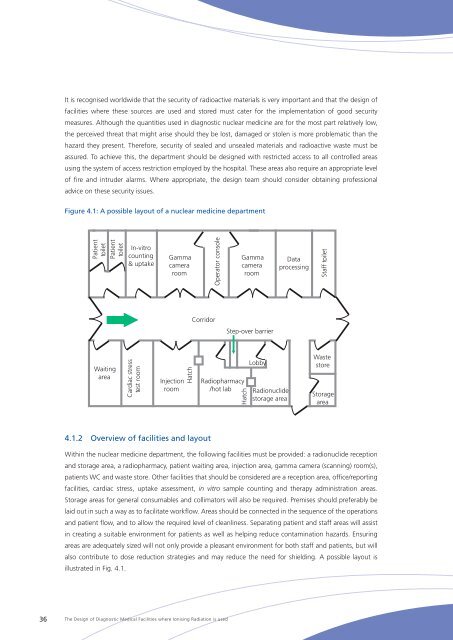The Design of Diagnostic Medical Facilities where ... - ResearchGate
The Design of Diagnostic Medical Facilities where ... - ResearchGate
The Design of Diagnostic Medical Facilities where ... - ResearchGate
Create successful ePaper yourself
Turn your PDF publications into a flip-book with our unique Google optimized e-Paper software.
It is recognised worldwide that the security <strong>of</strong> radioactive materials is very important and that the design <strong>of</strong><br />
facilities <strong>where</strong> these sources are used and stored must cater for the implementation <strong>of</strong> good security<br />
measures. Although the quantities used in diagnostic nuclear medicine are for the most part relatively low,<br />
the perceived threat that might arise should they be lost, damaged or stolen is more problematic than the<br />
hazard they present. <strong>The</strong>refore, security <strong>of</strong> sealed and unsealed materials and radioactive waste must be<br />
assured. To achieve this, the department should be designed with restricted access to all controlled areas<br />
using the system <strong>of</strong> access restriction employed by the hospital. <strong>The</strong>se areas also require an appropriate level<br />
<strong>of</strong> fire and intruder alarms. Where appropriate, the design team should consider obtaining pr<strong>of</strong>essional<br />
advice on these security issues.<br />
Figure 4.1: A possible layout <strong>of</strong> a nuclear medicine department<br />
Patient<br />
toilet<br />
Patient<br />
toilet<br />
In-vitro<br />
counting<br />
& uptake<br />
Gamma<br />
camera<br />
room<br />
Operator console<br />
Gamma<br />
camera<br />
room<br />
Data<br />
processing<br />
Staff toilet<br />
Corridor<br />
Step-over barrier<br />
Waiting<br />
area<br />
Cardiac stress<br />
test room<br />
Injection<br />
room<br />
Hatch<br />
Radiopharmacy<br />
/hot lab<br />
Hatch<br />
Lobby<br />
Radionuclide<br />
storage area<br />
Waste<br />
store<br />
Storage<br />
area<br />
4.1.2 Overview <strong>of</strong> facilities and layout<br />
Within the nuclear medicine department, the following facilities must be provided: a radionuclide reception<br />
and storage area, a radiopharmacy, patient waiting area, injection area, gamma camera (scanning) room(s),<br />
patients WC and waste store. Other facilities that should be considered are a reception area, <strong>of</strong>fice/reporting<br />
facilities, cardiac stress, uptake assessment, in vitro sample counting and therapy administration areas.<br />
Storage areas for general consumables and collimators will also be required. Premises should preferably be<br />
laid out in such a way as to facilitate workflow. Areas should be connected in the sequence <strong>of</strong> the operations<br />
and patient flow, and to allow the required level <strong>of</strong> cleanliness. Separating patient and staff areas will assist<br />
in creating a suitable environment for patients as well as helping reduce contamination hazards. Ensuring<br />
areas are adequately sized will not only provide a pleasant environment for both staff and patients, but will<br />
also contribute to dose reduction strategies and may reduce the need for shielding. A possible layout is<br />
illustrated in Fig. 4.1.<br />
36<br />
<strong>The</strong> <strong>Design</strong> <strong>of</strong> <strong>Diagnostic</strong> <strong>Medical</strong> <strong>Facilities</strong> <strong>where</strong> Ionising Radiation is used
















